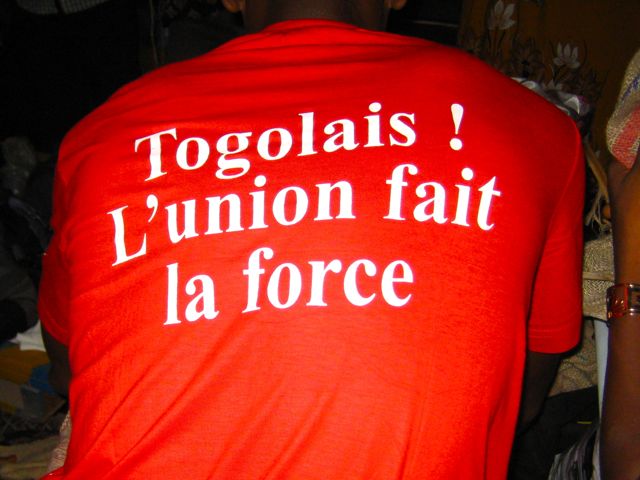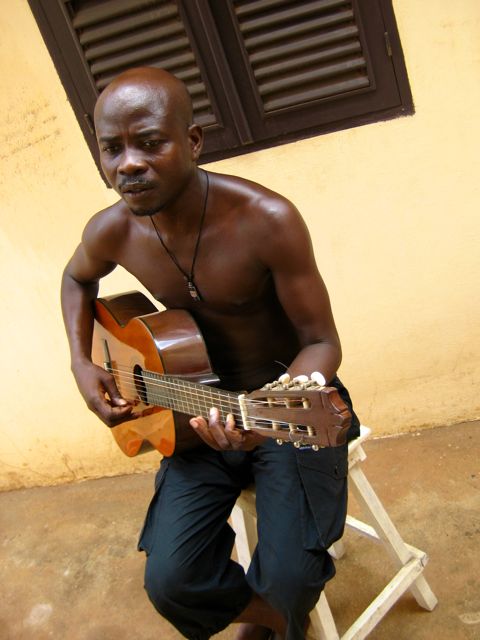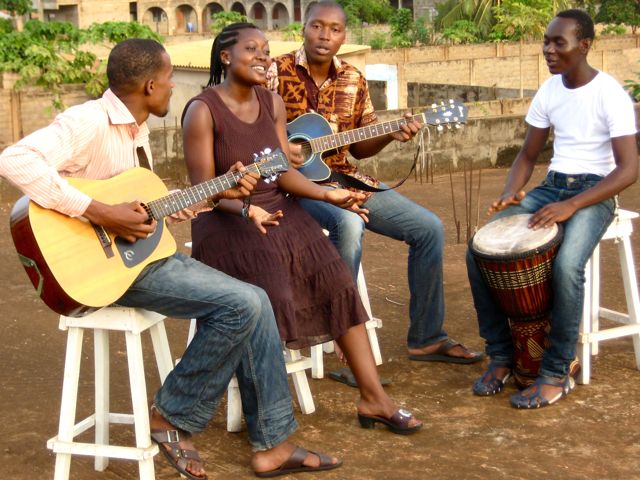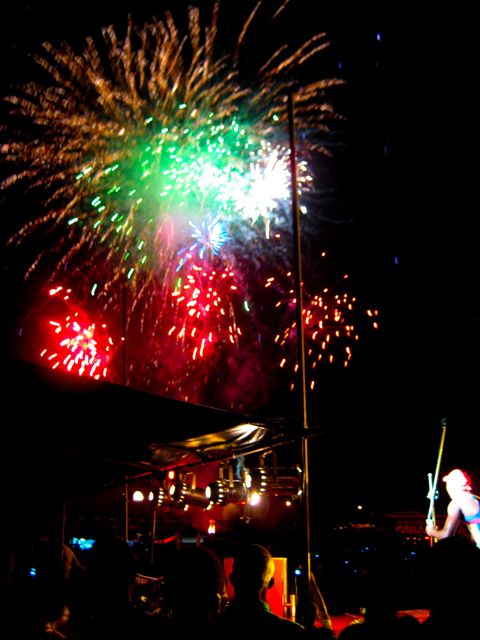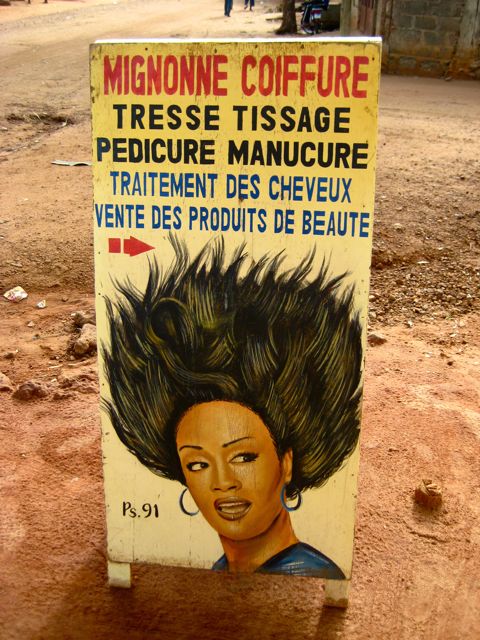Schmoozin’ in Accra
We’ve been really, really bad about keeping the site up to date these last couple of weeks. We’re just too busy schmoozin’ around in Accra! These photos will give you a quick taste of the types of encounters we’re making on the ground in Ghana. Left to right, top to bottom:
– Wanlov the Kubolor and Gyedu-Blay Ambolley
– Ananse practicing xylophone with members of Daoma (Burkina Faso)
– Ananse being subtle
– Ananse with King Ayisoba
– Benjamin with Abraham of OM Studios
– Benjamin with Appietus at his studio in Dansoman
– Kojo the sculptor just back from his village with another incredible mask
– Benjamin with Skillions’ ill beat maker Jay So at his studio in Adenta
– Jay So kickin’ back
– Efya being a beautiful dork with some friends
– Jada Sparkle & Stonebwoy Burniton
– last but not least, Ladji, our Francophone buddy, an art dealer visiting from Abidjan. Sagacité!
Northern Ghana
Northern Ghana from Akwaaba Music on Vimeo.
I’ve been trying to leave Tamale in the north of Ghana all day, which leaves me with plenty of time to fill you in.
What do we know about the North of Ghana? It’s fairly isolated from the south, where both major cities sit: Accra the economic heart of the country, and Kumasi, center of the dominant Ashanti culture. Culturally the north is quite different, it’s a sahelian society, the climate is much drier, hotter, and the culture is much closer to what we saw in places like Mali.
Yet there is hardly any communication with the neighboring Sahelian – Francophone – countries. The north seems like such a cul-de-sac really: artificially landlocked from neighboring Francophone countries (Burkina mostly, with Togo and Cote d’Ivoire on each side), and politely ignored for the most part from the more afluent and populous south.
That explains how isolated the culture – and music – have remained. King Ayisoba is probably the most famous voice coming from the region, although to most readers he’s probably still a complete unknown. Look up his music on myspace or iTunes, Ayisoba has an incredible voice, but will leave you thinking he has two or three!
Besides Ayisoba, whom we’ll get back to soon, there is almost no structure in place for music. Musicians stick to the traditional circuit, mostly playing for funerals and weddings, sometim. That’s for the traditional musicians, for the home studio generation there are almost no shows, no bars to play at. So not much of an industry.
Yet – and you saw this coming – TONS OF RAW TALENT. We’ve got beautiful videos which our connection won’t really allow us to post just yett, but check in soon for more.
More Sapeurs in Colors Mag
You know we love this stuff… remember the Gentlemen of Bakongo?
Welcome to Togo
Most people think of Togo as a way to have food ordered. But it’s also a sliver of a country sandwiched between Ghana and Benin, a nation some may know for its gnarly ties to international – in particular French – money, arms and drugs scandals. The Gnassimbe dynasty has kept power within arms reach for decades, it is one of the finest examples of corruption in the world, the elite is particularly disinterested in the dire state of the country, which despite abundant mineral and agricultural wealth, is stuck in a rot. The rot is ibvous when entering from Ghana: one side of the border has buildings with rooms and computers. The other side has a shack with officers holding LED flashlights to fill in the paperwork. Sorry, photos of that were not so welcome.
The poor leadership and lack of development in the country are reflected by its extremely poor cultural reach. If anyone reading this can name ONE single Togolese musician, or even any kind of artist based in Togo, we’ll give you some free music!! More than in any country we’ve visited, there are hardly any structures to decently record and produce music, there is very limited access to foreign culture, besides the usual top 40 + garbage 40 (Celine Dion….).
BUT…. culture is very much alive. Hip hop took the country by storm since the mid 1980s, although it took over a decade for it to finally be accepted on the radio. Today hip hop is the dominant style for the Togolese youth, who sing in French, but mostly in Ewe and other regional Togolese languages. The hip hop is mostly influenced by what kids hear on the radio, which is – unfortunately – quite limited. 50 Cent, Akon, Tupac, and some French cats as well. We don’t want to hate on these major artists (actually we do, but we shouldn’t), but we believe there should be room for more. And finally now that internet access is trickling in, kids have some broader access to foreign music and culture.
As a result a new generation of artists is experimenting with the music. We were fortunate to meet with acts such as Dodji (photo of guy with guitar below) and Elinam (full band photo below), who blend a lot of foreign influences with elements of traditional folklore, in particular Ewe and coastal drumming techniques, which are impressively elaborate. We hope to work with such artists so stay tuned…
We should also note last Tuesday April 27 marked Togo’s 50th independence anniversary, hence the fireworks:
And we couldn’t resist but share some of the visuals…. hairdressers do it best over here:
Anlo-Ewe Drum Ensemble…on drum set!
Hey African music fans! I’d like to take this opportunity to say “Miawoezor” (that’s “welcome,” or “akwaaba” in the Ewe language) to Benjamin, who has just arrived in Ghana. In honor of his trip, I decided to take a break from my samba-semba blog entries and write a little bit about traditional Ghanaian music.
The dance-drumming of the Anlo-Ewe society of Southeastern Ghana features a complex rhythmic interplay between three supporting drums and a master drum. The ensemble also includes a bell, which acts as the conductor, and several rattles, which embellish the basic rhythm played by the bell.
Check out this video of Agbadza, a traditional Ewe dance. It’s a little long, but it really captures what it’s like to attend a dance-drumming event in an Ewe village. There are great shots of the drummers at 4:45, 6:31 and 7:40.
What I find most fascinating (and most frustrating) about Anlo-Ewe music is that it’s impossible to play it alone—you need at least five people—unlike music in the Western tradition, where individual practice is necessary for group success. Drummer Kevin O’Sullivan has had a brilliant solution to this problem: he has arranged Anlo-Ewe rhythms for drum set, assigning each limb a different part of the Ewe drum ensemble. Check out his arrangement of Atsiã, an Ewe social dance:
If you’re interested in seeing it performed live (with dancers!), percussionist Amanda Duncan will be playing it on her senior recital at Cal State Long Beach on May 15th, 2010 at 8pm in Daniel Recital Hall. And if you want more info on Anlo-Ewe dance drumming, O’Sullivan’s website is one of the best resources I’ve found on the web; be sure to check it out!
Miadogo! (See you later!)
>>Catherine


